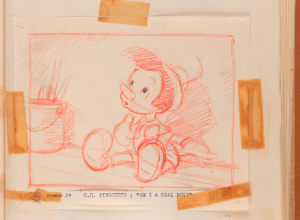Remnants of Everyday Life Opens at the Library Company on May 13
Philadelphia, Pennsylvania—May 8, 2013—Remnants of Everyday Life: Historical Ephemera in the Workplace, Street, and Home highlights the Library Company's vast collection of ephemera from the 18th to the early 20th century. With materials ranging from throw-away items to finely printed works, Remnants of Everyday Life considers the cultural impact of advancements in mass production technologies.
The exhibition will address the evolution of the graphic design of ephemera; ephemera associated with women's role in the home, such as scrapbooks; the changing nature of leisure activities and consumerism over the course of the 19th century; and the life-cycle of commercial ephemera between the workplace, street, and home.
Old and young, rich and poor, our forbearers participated in a vibrant popular culture whose medium was printed ephemera. Remnants will exhibit broadsides, playbills, fliers, postcards, trade cards, tickets, menus, World's Fair souvenirs, labels, stereographs, albums, scrapbooks, paper dolls and other ephemeral toys and games, and advertisements. Specific examples include the 1897 billhead for Mrs. Henrietta S. Duterte, an African American undertaker and possibly the first female embalmer in the country; examples of Victorian-era paper bags, including the-then novel "Square Bag" patented in 1872; the seminal 1870 printing manual Typographia, which broke new ground for commercial graphic design; and one of the first illustrated circus posters issued in 1828.
The Library Company has been collecting ephemera since 1785, when it acquired the Pierre Eugène Du Simitière collection of Revolutionary War-era pamphlets and broadsides. Today it has one of the largest, most important, and most varied collections of early American ephemera in existence. In 2012, the Library Company completed a two-year project funded by the National Endowment of the Humanities to arrange, catalog, and selectively digitize nearly 30,000 pieces of 18th- and 19th-centry ephemera.
An outgrowth of this project, Remnants of Everyday Life, curated by Visual Culture Program co-Directors Rachel D'Agostino and Erika Piola, is on view from Monday, May 13, through Friday, December 13, 2013. In a public talk scheduled in conjunction with the exhibition opening, Dr. Ellen Gruber Garvey will discuss the history of scrapbooking. The exhibition and its accompanying programming are supported by funds from the Pennsylvania Council on the Arts and the Philadelphia Cultural Fund.
Visual Culture Program (VCP) at the Library Company of Philadelphia
Launched in 2008, VCP at LCP promotes the use of historical images as primary sources for studying the past and fosters research, collection, and interpretation of historic visual material. Scholars and the general public are increasingly aware of the importance of visual images in examining the past. With the proliferation of sophisticated digitization technologies, researchers now have the opportunity to "see" images in new ways. No longer considered secondary to text, visual materials are taking their rightful place as primary evidence documenting the past and influencing our understanding of the present. Through exhibitions, research fellowships, conferences, and public programs, VCP at LCP promotes the creative use of the Library Company's varied collections of visual materials.
The Library Company of Philadelphia
The Library Company of Philadelphia is an independent research library specializing in American history and culture from the 17th through the 19th centuries. Founded in 1731 by Benjamin Franklin, the Library Company is America's oldest cultural institution and served as the Library of Congress from the Revolutionary War to 1800. The Library Company was the largest public library in America until the Civil War and includes the extensive personal libraries of such prominent early American bibliophiles such as James Logan. Open to the public free of charge, the Library Company houses an extensive collection of rare books, manuscripts, broadsides, ephemera, prints, photographs, and works of art, and the second largest holding of early American imprints. Particular strengths of the collection include economic history, women's history, African American history, history of medicine, history of philanthropy, and visual culture. To find out more, please visit www.librarycompany.org.















